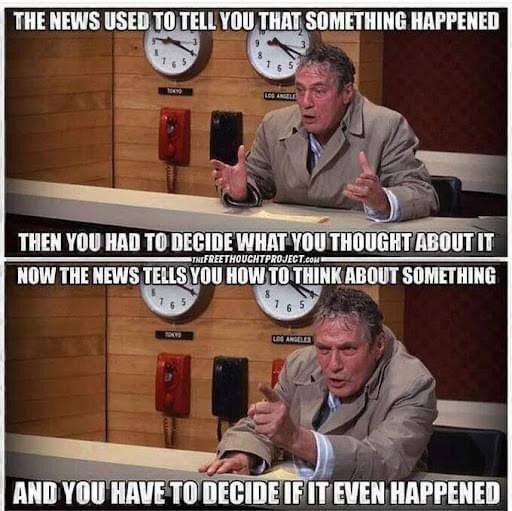Disorientation and Information Dispersal
Converging trends in control and dominance.
The 2022 Russian invasion of Ukraine, has displayed major fissures within Western societies. One such fissure is folk who have become so distrustful of mainstream Western media that they don’t regard then as a reliable source for anything. To the extent some were at first sceptical that the Russian invasion was even real. Months further in, such events as the Bucha massacre are treated as a fabrication, either whether they happened at all or whether the Russian invaders were responsible.
The second, and overlapping, fissure is those who are so revolted and alienated from Western “progressive” elites, that anyone or anything fighting them looks better, or even good. Given that the hormonal and surgical mutilation of minors is now morally cutting edge, and there is an industry profiting from said mutilation, including the castration boys and the sterilisation of girls, there is a lot to be rightfully alienated from.
And yet. The effect of the above is not to create fearless truth seekers, it is to make folk even easier prey for Kremlin propaganda and talking points. Such bringing up the 2014 Odessa killings (yes, the Maidan Revolution/Revolution of Dignity included violence) or Ukrainian shelling in the Donbas (yes, there was an ongoing border war, started by Russia and its proxies) as somehow explanatory or justifying Russian action.
A disorienting information environment is what the Putin regime seeks to create and how it operates. In Russia, the “deep state” is out in the open because that is what the regime is based around.
The Western media pissing away trust in the ways it systematically has, both works for Putin in creating an information environment useful for his regime and represents converging tendencies across democratic and autocratic societies of information disorientation that social media intensifies.
The aforementioned fissures are not much evident in mainstream public discourse, but these “non-public” patterns existed from the start of the Russian invasion.
Bad plan
A mistake that I and others fell into in the early stages of the invasion was to over-state the apparent incompetence of the Russian army. The Russian air force and navy have clearly underperformed. The provision of Western intelligence from AWACs aircraft and related sources was a game-changer for the Ukrainians. Western AWACs and other intelligence, plus missile supplies, denied Russians air superiority and have enabled Ukrainian missiles to systematically pick off the Russian Black Sea Fleet. To the extent of the Ukrainian retaking Snake Island, despite lacking naval forces.
The real problem with the initial Russian attack is that they had a bad plan. They thought they could do an easy blitzkrieg and Ukrainian resistance would collapse, Crimea 2014 style. So the Russian forces would not, for instance, need fuel and food trucks in the advance on Kyiv. It would be straightforward for paratroopers to seize Hostomel airport and fly supplies in.
Clearly no. Air superiority was never established; Ukrainian forces initially repelled the Russian paratroopers; President Zelenskyy made his iconic “I don’t need a ride, I need ammunition” statement; Ukrainian light infantry with hand-held anti-tank missiles brought the columns, operating with insufficient infantry support, to a vulnerable halt. So, the northern Russian attack on Kyiv was defeated and the Russian forces withdrew.
Russian advances in the South and East were more successful, though they were pushed back from Kharkiv and stopped short of Mykolaiv. The Russian Army is now using its operational mainstay for over a century—massive artillery bombardment—to grind forward in the Donbas. They are advancing, but very slowly. This means that, while the Ukrainians are being driven back, they must be retreating in good order. In such a war of attrition the question is who is losing relatively more, as per the Lanchester Equations.
The Russian story is that key Ukrainian cadres are being chewed up.
The Ukrainian story is that they are bleeding the Russians to exhaustion.
Military conflict is perhaps the most intense reality-test in human affairs, so we will see.
It is clear that the Russians have a major problem with systematic corruption in their military. Yes really.
It seems likely there are also issues in their intelligence services. It seems pretty clear that one reason the Russians started with a bad plan is that Putin didn’t know what he didn’t know.
For understanding the context, this is a very clarifying thread about the 2014 Maidan Revolution and how that represented Ukraine transitioning to a full post-Soviet state, with a significantly new state cadre, thereby breaking links with the Russian state apparatus. Hence Russian mis-estimation of the Ukrainian response. (Also, that the Russian regime has apparently killed off almost all the Donbas warlords, likely for control reasons.)
Folk have cited the Winter War as an analogy with the current invasion. Despite the striking effective heroism of the Finnish forces in the early stages of that war, the Soviet Union won the Winter War, though Ukraine has been receiving far more Western aid than Finland did and the population imbalance is not as catastrophic.
The full reality-test of war has not played out as yet. And the importance of the willingness of the West to support Ukraine means that perceptions interact with the military struggle. With Russian information efforts clearly being aimed at undermining confidence that Ukraine can prevail.
In the early days of the invasion, I published a second piece Helen Dale’s Substack about corrupted and disorienting information environments, where I discuss how Putin does not represent relief from alienating and corrupting discourse-patterns in Western societies, but more intense versions of them.


